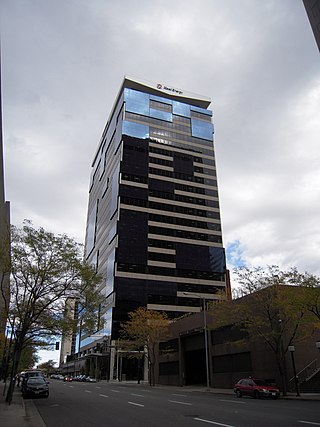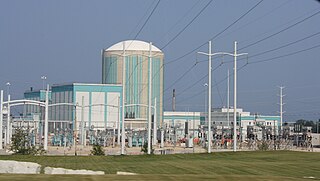
A boiling water reactor (BWR) is a type of light water nuclear reactor used for the generation of electrical power. It is the second most common type of electricity-generating nuclear reactor after the pressurized water reactor (PWR), which is also a type of light water nuclear reactor.

The Duane Arnold Energy Center (DAEC) was Iowa's only nuclear power plant. It is located on a 500-acre (200 ha) site on the west bank of the Cedar River, two miles (3.2 km) north-northeast of Palo, Iowa, USA, or eight miles (13 km) northwest of Cedar Rapids.

Xcel Energy Inc. is a U.S. regulated electric utility and natural gas delivery company based in Minneapolis, Minnesota, serving more than 3.7 million electric customers and 2.1 million natural gas customers across parts of eight states. It consists of four operating subsidiaries: Northern States Power-Minnesota, Northern States Power-Wisconsin, Public Service Company of Colorado, and Southwestern Public Service Co.
Northern States Power Company (NYSE: NSP) was a publicly traded S&P 500 electric and natural gas utility holding company based in Minneapolis, Minnesota, that is now a subsidiary of Xcel Energy.

Arkansas Nuclear One (ANO) is a two-unit pressurized water nuclear power plant located on Lake Dardanelle outside Russellville, Arkansas. Owned by Entergy Arkansas and operated by Entergy Nuclear, it is the only nuclear power facility in Arkansas.

The Prairie Island Nuclear Generating Plant is an electricity-generating facility located in Red Wing, Minnesota, along the Mississippi River, and adjacent to the Prairie Island Indian Community reservation.
The Monticello Nuclear Generating Plant is a nuclear power plant located in Monticello, Minnesota, along the Mississippi River. The site, which began operating in 1971, has a single nuclear reactor of the General Electric BWR-3 design generating 671 MWe. The plant is owned by Xcel Energy and operated by Northern States Power, its regional subsidiary.

The Pathfinder Atomic Power Plant was a nuclear power plant built by Northern States Power Company. It was located just northeast of Sioux Falls, South Dakota, and west of its suburb of Brandon. It was named for the 19th century explorer John C. "Pathfinder" Fremont and was constructed in the mid-1960s in partnership with a group of other investor-owned utilities. The main goal of this facility was to be a 'proof of concept' plant to gain practical experience in operating a nuclear plant. Some of the other participating utilities would also go on to build their own plants. The superheater developed by Allis-Chalmers was plagued with technical difficulties, after the plant first fission in 1964. After two years the Station first began to generate electricity to the grid, and after only about a year, on September 16 1967 an accident occurred which led to NSP's decision to retire the reactor, the lessons NSP learned from Pathfinder served the company in its operation of the Prairie Island and Monticello nuclear plants. The longest Pathfinder ever ran at its full rated power was 30 minutes, and it was only then the company found the flaws that led to the decision to retire the reactor. After sitting idle for 23 years, the reactor vessel was removed from the plant in 1990 and transported to a low-level radioactive material dump in Washington.

River Bend Nuclear Generating Station is a nuclear power station on a 3,300-acre (1,300 ha) site near St. Francisville, Louisiana in West Feliciana Parish, approximately 30 miles (50 km) north of Baton Rouge. The station has one sixth generation General Electric boiling water reactor that has a nominal gross electric output of about 1010 MWe. Commercial operation began on June 16, 1986. In 2003, owners applied and were approved for a power upgrade of approximately 52 megawatts in 2003. The nameplate capacity is 974 MW.

The Kewaunee Power Station is a decommissioned nuclear power plant, located on a 900 acres (360 ha) plot in the town of Carlton, Wisconsin, 27 miles (43 km) southeast of Green Bay, Wisconsin in Kewaunee County, and south of the city of Kewaunee.

Point Beach Nuclear Plant is a nuclear power plant located on Lake Michigan in the town of Two Creeks, Wisconsin, United States. The plant was built by Wisconsin Electric Power Company, and previously operated by the Nuclear Management Company. The plant is currently owned and operated by NextEra Energy Resources, of Juno Beach, Florida.
The "Nuclear Power 2010 Program" was launched in 2002 by President George W. Bush in 2002, 13 months after the beginning of his presidency, in order to restart orders for nuclear power reactors in the U.S. by providing subsidies for a handful of Generation III+ demonstration plants. The expectation was that these plants would come online by 2010, but it was not met.
WEC Energy Group is an American company based in Milwaukee, Wisconsin that provides electricity and natural gas to 4.4 million customers across four states.

La Crosse Boiling Water Reactor (LACBWR) was a boiling water reactor (BWR) nuclear power plant located near La Crosse, Wisconsin in the small village of Genoa, in Vernon County, Wisconsin, approximately 17 miles south of La Crosse along the Mississippi River. It was located directly adjacent to the coal-fired Genoa Station #3. The site is owned and was operated by Dairyland Power Cooperative (Dairyland). Although the reactor has been demolished and decommissioned, spent nuclear fuel is still stored at the location.

Alliant Energy Corporation is a public utility holding company headquartered in Madison, Wisconsin, providing power in Iowa and Wisconsin.

Wisconsin Public Service Corporation (WPS) is a utility company headquartered in Green Bay, Wisconsin. The company serves more than 450,000 electric customers and more than 333,000 natural gas customers in 27 counties in eastern, northeastern northern, and central Wisconsin, and a small portion of Michigan's Upper Peninsula.

NextEra Energy Resources, LLC (NEER) is a wholesale electricity supplier based in Juno Beach, Florida. NEER is a subsidiary of NextEra Energy, a Fortune 200 company. Prior to 2009, NextEra Energy Resources was known as FPL Energy.

The Sherburne County Generating Station, also known as Sherco, is a large coal-fired power plant on the banks of the Mississippi River in Becker, Minnesota, which is in Sherburne County. Its three units have a combined capacity of 2,238 megawatts, making it the largest power plant in the state. In comparison, the single-unit Monticello Nuclear Generating Plant located less than four miles away has an output of 671 MW. The state's other nuclear power plant, the 2-unit Prairie Island facility, is rated at 1,096 MW, so Sherco has a larger peak output than those plants put together. The station uses 20,000 to 30,000 tons of coal per day. The BNSF Railway delivers up to three 115-car trains per day from mines in the Powder River Basin.














